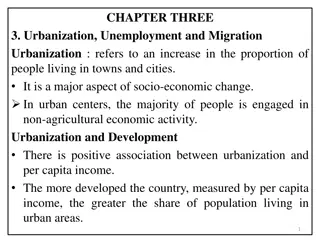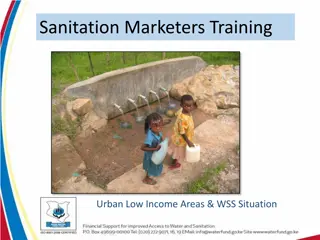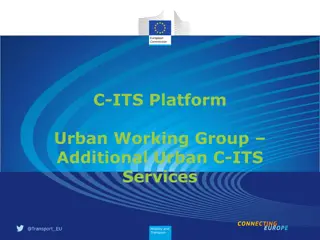Advantages of Public Option in Urban Essential Services
Public funding and delivery of urban essential services have shown to reduce inequalities, create employment, contribute to economic growth, and improve health outcomes. Examples from countries like Costa Rica highlight the benefits of publicly funded healthcare systems. Re-municipalisation is a growing trend due to failures of privatization, with examples like Norrtalje in Sweden implementing integrated care systems. Inter-municipal cooperation is also being used to improve service quality and promote regional development.
Download Presentation

Please find below an Image/Link to download the presentation.
The content on the website is provided AS IS for your information and personal use only. It may not be sold, licensed, or shared on other websites without obtaining consent from the author. Download presentation by click this link. If you encounter any issues during the download, it is possible that the publisher has removed the file from their server.
E N D
Presentation Transcript
THE MANY ADVANTAGES OF THE PUBLIC OPTION FOR FINANCING AND DELIVERY OF URBAN ESSENTIAL SERVICES Dr. Jane Lethbridge, Director, Public Services International Research Unit (PSIRU), University of Greenwich, UK 26 July 2016 HABITAT III, PREPCOM3 SURABAYA, INDONESIA Teaching excellence for over 100 years Teaching excellence for over 100 years
WHY PUBLIC FUNDING & DELIVERY? In 19th & 20th centuries public funding and delivery of services played key role in urban development following failures of private provision Lack of evidence to show that private provision is more effective and efficient than public provision in health, social care, education, water & waste management services in both the Global North and South However, growing evidence to show that publicly funded/delivered services help to: Reduce inequalities (Wilkinson & Pickett, 2009); Create employment - public/ municipal services (ILO, 1998; OECD, 2008); Contribute to improved rates of economic growth (Bose et al, 2007; Strittmatter & Sunde (2011); Improve health outcomes, e.g. reduction of infant mortality (Tacke & Waldman, 2011). Example: Costa Rica introduced a universal health system (UHS) (a single public entity that provides and funds all medical and preventive services to citizens, free at the point of use) resulted in improved satisfaction from users, lower catastrophic health costs, almost full population coverage (96.4%) and continuing reductions in infant and adult mortality (Hernandez & Salgado, 2014). Teaching excellence for over 100 years
REMUNICIPALISATION Failure of privatisation of essential services resulted in strong social resistance and demands for re-municipalisation a global trend different public services (PSIRU, 2014) Triggers for re-municipalisation: corruption; lack of transparency; elections and political willingness; failure of private providers; need for new forms of service delivery Example: Norrtaelje, Stockholm, Sweden integrated health and social care, universal coverage & public programmes based on tax- based resources, public sector collaboration and transformation through use of a public company to develop new ways of delivering care to older people with no new funds (Back & Caltorp, 2015) Teaching excellence for over 100 years
INTER-MUNICIPAL COOPERATION Inter-municipal cooperation involves contracts or joint production with other local governments as a means to gain economies of scale, improve service quality, and promote regional service coordination within or between countries Example: Partnership between the Belgian town of Edegem (22,000 pop.) and the Peruvian municipality of San Jeronimo (pop.32,000) - a project that composts organic waste and uses it for agriculture. 2004 partnership started identified waste management as common problem - created a system to collect organic waste in the market and from houses shared learning about composting and awareness raising by municipality of local communities of importance of separating out organic waste Waste taken to mountains where municipality owned land and also arrangement with local farmers to use their land and give compost in return. Job creation. People who collect other forms of waste helped to form cooperative municipality provided working clothes and gloves improved local collaboration Edegem is a member of VVSG (Association of Flemish Cities and Municipalities), member of PLATFORMA, the European network of local and regional authorities for development (Gotev, 2015). Teaching excellence for over 100 years
PUBLIC-PUBLIC PARTNERSHIPS (PUPs) Collaboration between two or more public authorities or organisations, based on solidarity, to improve the capacity and effectiveness of one partner to provide public services. Peer relationships forged around common values/interests and objectives but which exclude profit-seeking. Absence of commercial considerations allows public partners to reinvest resources into local capacity, to build a mutual trust which translates into long term capacity gains with low transaction costs. Example: A network of international PUPs enabled the city of Phnom Penh, Cambodia to increase water supply coverage from 20% in 1993 to 90% in 2007. Public utility PPWSA expanded access to water supply in Phnom Penh faster than in PPPs anywhere in the world (Hall et al, 2009). Teaching excellence for over 100 years
CONCLUSION Publicly funded/ delivered essential services contribute to a more equal distribution of resources in society Re-municipalisation allows local authorities to take control over essential services and plan for changing local needs Inter-municipal cooperation draws local authorities together within and across countries to improve services through solidarity and shared expertise Public-Public partnerships draw public institutions together to deliver services, again sharing expertise and resources to make improvements in essential services Unlike the private sector, which has to answer to the demands of investors and shareholders, these three alternatives highlight importance of municipal collaboration and solidarity in addressing the needs of local populations now and in future. Teaching excellence for over 100 years





























